"Unfortunately, the German Organic Farming Act has become a very complex set of legal regulations over the years," said Dr. Jochen Neuendorff of the GfRS organic control agency at the beginning of the online webinar 'Gold, Silver, Bronze or Just Labelling? Ways to Calculate the Monetary Value of Organic Ingredients in Out-of-Home Catering'. "Since the last revision, we now look at two main regulations and 16 secondary regulations in the area of food processing, which have to be read in a zigzag pattern to know which requirements have to be met." Accordingly, enthusiasm among voluntary users has been relatively limited.
 © GfRS / a'verdisDr Jochen Neuendorff and Rainer Roehl
© GfRS / a'verdisDr Jochen Neuendorff and Rainer Roehl
Therefore, the aim was to create a national law similar to that in Denmark – the Bio-Außer-Haus-Verpflegung-Verordnung (en.: Organic Out-of-Home Catering Ordinance, Bio-AHVV). "The goal was to reduce the effort required by certified kitchens. The minimum that should be provided by a kitchen is labeling of ingredients and products." In addition, the bronze, silver, and gold logos have been added, following the Danish model. "Daycare centers and schools that cook for their own needs on site are exempt from the certification requirement, unless they wish to use the logo."
The Bio-AHVV applies in the broadest sense to all companies that provide out-of-home catering and has two central goals: simple, clear, honest labeling and a certification that makes a commitment to organic products visible. The logo is an add-on. "It is an additional way to make your organic content recognizable in the form of a bronze, silver, or gold logo," explained Rainer Roehl of a'verdis. "It is a certification that goes beyond labeling, and the organic control agency is then tasked with verifying whether the specified organic content is actually implemented." The logo is divided into three levels: bronze, with 20 to 49 percent monetary organic share; silver, with 50 to 89 percent; and gold, with 90 to 100 percent.

How is the organic share calculated?
"The calculation itself is done by the kitchens," Neuendorff continued. A different logo may be relevant for each kitchen that is an operating unit. "So the individual operating units document and the kitchen calculates the monetary value of the organic food as a percentage of the total food purchases. The organic control bodies check the calculations and decide whether a certificate with the Bio-AHV logo can be issued. The legislator has determined that for the first inspection, the average value based on the total purchase of goods in the past three months before the inspection visit is relevant, and for subsequent inspections, the average value of the organic share from the last 12 months." This allows, for example, seasonal fluctuations to be balanced out.
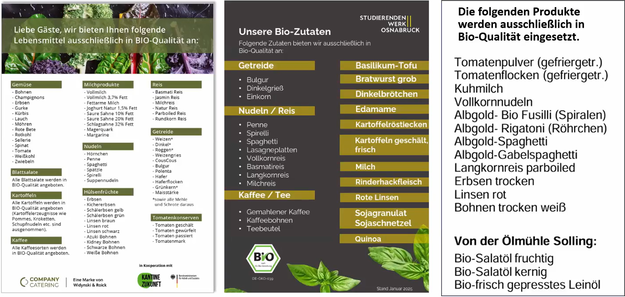 © a'verdis/GfRSExamples of customer communication
© a'verdis/GfRSExamples of customer communication
The Bio-AHVV requires that the net total of all organic and non-organic ingredients and products be documented monthly as a net total. Products that are not food, such as organic cleaning agents and water, are not to be included in the calculation.
Documentation options for the calculation
During the webinar, Neuendorff and Roehl presented four documentation options for calculation. "In our experience, these are the four options that are currently being used, which are very helpful and with which an organic control agency can also check everything very well," emphasized Roehl.
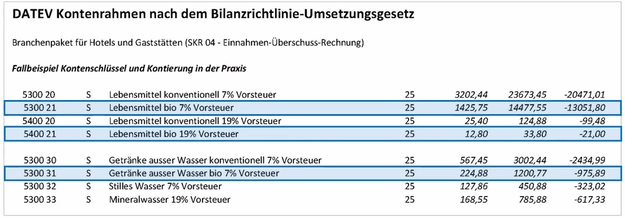 © a'verdis/GfRSExample of documentation via accounting
© a'verdis/GfRSExample of documentation via accounting
On the one hand, accounting could be used to simplify documentation, for example, by using separate customer numbers for suppliers that differentiate between organic and conventional or monthly cumulative invoices. Additional accounts for operating expenses also simplify the process. "We consider accounting to be the simplest way of documenting, since it usually always has to be done for the tax office. The recorded data is then routinely included in the tax accounting and provides the output values," said Neuendorff
 © a'verdis/GfRSOverview of the documentation aid
© a'verdis/GfRSOverview of the documentation aid
In addition, a'verdis has prepared and expanded a documentation aid, said Roehl. "An Excel spreadsheet that makes it very easy to calculate the organic share month by month. In addition, the logo is also automatically evaluated. This documentation tool has been deliberately designed to make it easy to enter the data, but of course, it must be entered. It is not automated." The documentation aid can be downloaded from oekolandbau.de.
 © a'verdis/GfRSExample of documentation using inventory management systems
© a'verdis/GfRSExample of documentation using inventory management systems
The organic share can also be calculated using inventory management systems such as Delegate or JOMOsoft. "The corresponding data is exported to an Excel spreadsheet for a month retroactively, and then the organic share is calculated using a filter. Of course, some kitchen managers or facility managers in the institutions already did the math ten years ago, very often with homemade, sometimes very clever Excel spreadsheets." For example, with an overall slide for the months and separate spreadsheets for the individual suppliers, which automatically calculate the share using Excel formulas after the entry.
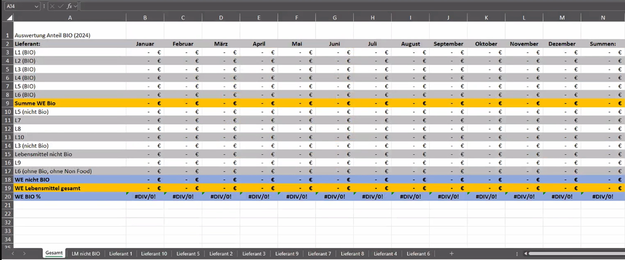 © a'verdis/GfRSScreenshot of an Excel sheet for documentation
© a'verdis/GfRSScreenshot of an Excel sheet for documentation
Complexities arise only in the case of double certification of companies with different lines of business. If these lines of business are "two separate areas, then they have to be kept apart. This has to be looked at a bit more closely in collaboration with the organic certification agency," Neuendorff emphasized in conclusion.
For more information:
Rainer Roehl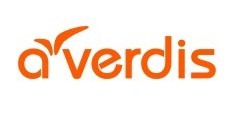
a'verdis
Mendelstraße 11
48149 Münster
Phone: +49 (0) 251 980 - 1220
Mail: info@a-verdis.com
https://averdishome.wordpress.com/
Dr Jochen Neuendorff
Gesellschaft für Ressourcenschutz mbH (GFRS)
Prinzenstraße 4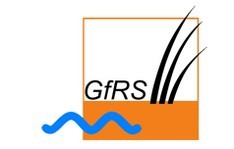
37073 Göttingen
Tel. producer: +49-551-37075347
Tel. processor: +49-551-4887731
Mail: jochen.neuendorff@gfrs.de
https://www.gfrs.de/

